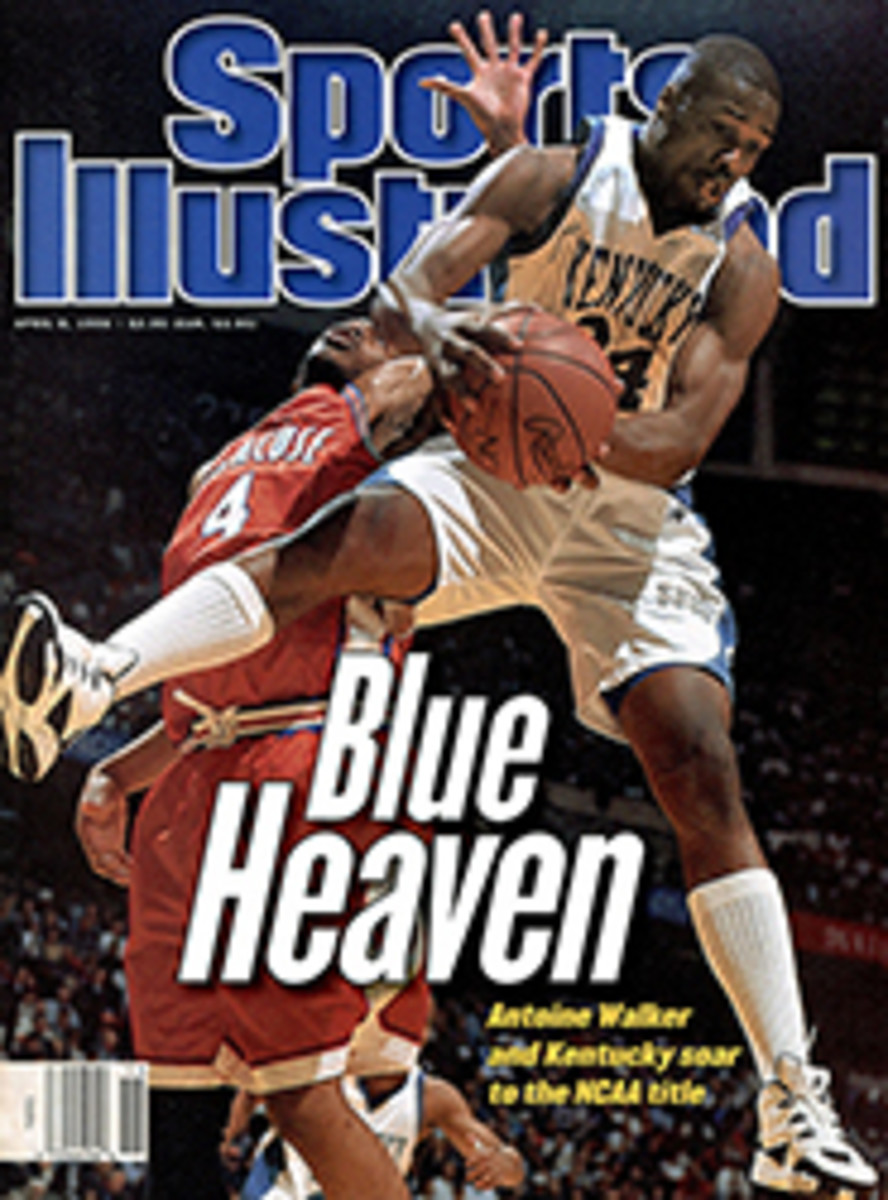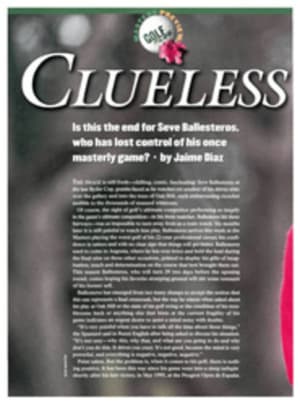
UNDONE BY ONE FOR PLAYERS AT THE MASTERS, THE 1ST HOLE IS OFTEN THE WORST HOLE
THE 1ST HOLE at Augusta National is not on anyone's list of
great golf landscapes. Tea Olive, as it is innocently called,
does not have a Rae's Creek or a Pacific Ocean to carry. It does
not have an island or a postage-stamp green. It does not have a
Swilcan Burn or a row of church-pew bunkers. Forget the bells
and whistles. All the 1st hole at Augusta has is 400 yards of
high anxiety.
Fuzzy Zoeller once described standing on the 1st tee as ''the
greatest natural laxative in the world.'' Jackie Burke said,
''It's like taking the first step on a high wire across Niagara
Falls.'' Ben Crenshaw thinks about it with both reverence and
fear. ''God bless it,'' he says.
As introductory holes go, Augusta's 1st is among the toughest in
major championship golf. Jack Nicklaus has always pointed to the
monster 470-yard, par-4 1st at Oakmont, host to seven U.S.
Opens, as the toughest opener. Ben Hogan ranked the 440-yard 1st
at Oak Hill, site of three Opens, as the hardest opening act.
But every year when the Masters starter says, ''Fore, please,"
this middle-distance four par becomes a marathon through a
minefield.
Only four players in Masters history have eagled the hole,
including Roberto de Vicenzo, who started eagle, birdie, birdie
in the final round in 1968 but a few hours later signed an
incorrect scorecard to knock himself out of a playoff with Bob
Goalby. Only four players have birdied the hole three out of the
four times they've played it. Curtis Strange did it in both 1984
and 1992. Last year's champion, Crenshaw, birdied it once, on
Friday. But that was one of just 16 birdies made on Tea Olive
for the week, the fewest birdies on any hole at Augusta. Only
the 4th hole was harder to par (3.275 to 4.264). ''It's just
sneaky tough,'' says Greg Norman.
Strategically the 1st hole follows Bobby Jones's intent at
Augusta to ''make bogeys easy if frankly sought, pars readily
obtainable by standard good play, and birdies, except on the
par-5s, dearly bought.'' Off the tee, the gaping bunker that
guards the right third of the fairway looks like the Mojave
Desert. Sixty-five feet from front to back, 40 feet wide and 4
1/2 feet deep, that pit of sand is the Andre the Giant of
Augusta National bunkers. It was course architect Alister
Mackenzie's answer to the long hitter who thought he could blow
it down the right side to open an angle of attack onto the
green. Nick Price drove it into that bunker during the third
round in 1986. It led to his only bogey the day that he tied the
course record of 63.
It takes a 257-yard drive to clear the bunker, but the carry
appears longer because the tournament committee lowered the 1st
tee two years ago, supposedly to make for better spectator
viewing. Some old-timers say the 1st tee used to be parallel to
the pro shop, which would be well forward from where it is now.
In truth, the hole was lengthened only slightly in the mid-'70s,
but the scorecard reads the same 400 yards that it has since
1934. "By the time they change the ground around at Augusta,''
says Nicklaus, ''you don't know if they moved the clubhouse or
the tee.''
Only about one third of the field can fly the bunker in calm
conditions. Into the wind, even a Price or a Norman has to shape
a shot into one of the few tight landing areas on the course, to
the left of the bunker.
The trouble with missing right of the bunker is a row of 33 tea
olive trees that remain from the 1910s, when a nursery sat on
the site of the course. Byron Nelson got into trouble there at
the start of his 18-hole playoff with Ben Hogan in 1942. Nelson
had to hit his second shot off pinecones into tree branches,
advanced his third over the green and ended up with double
bogey. He rallied by playing numbers 6 to 17 in six under par
and won the playoff 69 to 70.
Too far left off the tee is no picnic, either. A hard-running
draw can end up in the 9th fairway, behind a row of pine trees
that are 20 feet high. Even a fader of the ball like Nicklaus
has been seen playing a shot into the 1st green from number 9.
With danger just about everywhere, is it any wonder that when
Marty Fleckman stood on the tee for the first time, in 1969, he
felt a rush of panic and fear? He set up carefully, then hit a
ball that was last seen slicing toward Washington Road. It flew
over the scoreboard, over the Quonset hut media center, and off
in the general vicinity of the main patrons' entrance.
''Is that out-of-bounds?'' Fleckman asked.
''I don't know,'' the starter replied. ''No one has ever hit it
over there.''
The second shot at Tea Olive is one of the diciest at Augusta.
The green, which is crowned nine feet above the fairway, sits at
the highest point of the course, where there's plenty of wind to
play tricks with what appear to be well-struck shots. Norman
thought he had hit a wedge stiff to open the 1990 Masters. His
ball one-hopped over the back, and he made double bogey. He
never recovered, shot 78 and missed the cut.
''At Augusta you're trying to hit a box three feet by three feet
on every green,'' says Norman. ''You know if you hit it long,
you're going to die with it, and if you hit it short, you're
going to die with it as well. The 1st hole is exactly that way,
no matter where they have the pin. If you have a beautiful drive
and have a sand wedge in your hands, you still have to hit it in
that box.''
Lee Janzen shot 67 to open in 1993. He came back the next day,
obviously pumped to be leading, and went over the 1st green with
what he thought was a dead-on nine-iron. Double bogey. ''I was
posing on that shot,'' Janzen recalls with a shake of his head.
''I realized then that you can't just whip it onto that green
and think you'll have an easy two-putt for par.''
Even those who get on in two have discovered that the green can
turn putting into Goony Golf. Tiger Woods crushed a big drive
last year that easily carried the fairway bunker and followed
that with a sand wedge that rose above the trees, tore a pitch
mark three feet from the hole and stopped 25 feet away. All he
had to do was cozy the putt up to the hole and head to the par-5
2nd, a birdie hole where he could get in red numbers. Woods hit
the putt, liked it at first, then realized it was hit just a bit
too hard. It rose over the crest and started picking up speed,
tracking toward the cup. That's probably three feet by, he
remembers thinking. But the ball didn't stop at three feet. It
kept rolling and rolling another 18 feet and down the shaved
bank, off the green. Woods ended up scrambling for bogey and
shooting 72 in his Masters debut.
Woods wasn't the first and certainly won't be the last Masters
competitor to putt off that green. The first time he played the
Masters, Burke was paired with Ben Hogan. ''I thought I hit a
good putt, and then next thing I know, I'm down by the 9th tee
with a wedge,'' Burke said. ''I felt like an absolute fool.''
"The 1st hole at Augusta has a way of doing that,'' says
Strange. ''It's spooky to me."
COLOR ILLUSTRATION: ILLUSTRATIONS BY ARNOLD ROTH [Drawing of golfer teeing off at 1st hole at Augusta National, which is depicted as sand trap filled with other golfers]
COLOR ILLUSTRATION: ILLUSTRATIONS BY ARNOLD ROTH If the 1st tee is still 400 yards from the green, someone must have moved the clubhouse. [Drawing of golfer watching as workers move clubhouse with bulldozer]
COLOR ILLUSTRATION: ILLUSTRATIONS BY ARNOLD ROTH The 9th tee is sometimes where wayward putts on the 1st green go to die. [Drawing of golfer's putt rolling to where another golfer is teeing off]

